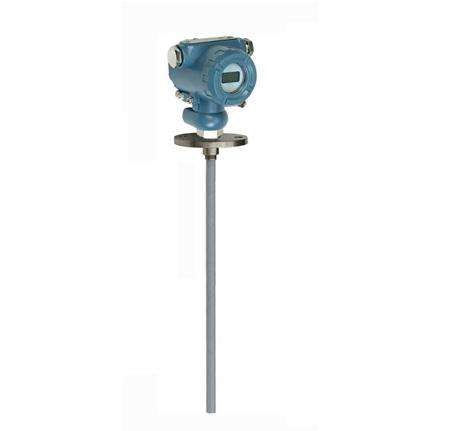Capacitive level gauge
Description
Capacitive level meter is suitable for continuous detection of various liquids under high temperature and high pressure, strong corrosion, easy crystallization, easy blockage and other harsh conditions. Suitable for measuring water level of sewage, acid and alkali solution and boiler, the whole machine has no movable or elastic parts, impact resistance, easy installation, high reliability and high precision. It can replace the traditional float type, input type, differential pressure type and other liquid level transmitters in various applications.
The core component of the capacitive level meter adopts rf capacitor detection circuit, which is transformed into standard electrical signal (generally 4-20 mA) after accurate temperature compensation and linear correction by 16-bit single-chip microcomputer. HART, CANBUS and 485 communication protocols are optional for system configuration. The whole series of transmitters have self-calibration function, users can use two keys for "zero", "range" automatic calibration, to adapt to the different requirements of a variety of complex places.
Products conform to GB3836.4-2000 "Electrical Equipment in Explosive Gas Environment part 4 Intrinsically Safe type" and GB3638.1-2000 "Electrical Equipment in Explosive Gas Environment Part 1 General Requirements", explosion-proof marks: Exia ⅱ C T6, it is suitable for zone 0, zone 1, zone 2, containing ⅱ A ~ ⅱ C, T1 ~ T6 group explosive gas mixtures.
Capacitive level meter features:
1, simple structure, no any movable or elastic components, so high reliability, very little maintenance. Under normal circumstances, it is not necessary to carry out conventional large, medium and small maintenance.
2, a variety of signal output, convenient for different system configuration.
3, suitable for high temperature and high pressure vessel liquid level measurement, and the measured value is not affected by the temperature of the liquid tested, specific gravity and container shape, pressure.
4, especially suitable for acid, alkali and other strong corrosive liquid measurement.
5, perfect over current, over voltage, power polarity protection.
Capacitive level meter performance:
1, detection range: 0.01~2000m
2, pressure range: -0.1mpa ~32MPa
3, temperature: -50~250℃
4, ambient temperature: -20~60℃
5, storage temperature: -55℃ ~ +125℃
6, output signal: 4 ~ 20mA, 4 ~ 20mA superimposed HART communication, 485 communication, CAN bus communication
7, power supply voltage: 12 ~ 28VDC (need to pass the safety grid power supply)
8, fixed mode: thread installation M20×1.5, M27×2,
Flange mounting DN25, DN40, DN50. Special specifications can be customized upon request
9, moisture material: 316 stainless steel, 1Gr18Ni19Ti or ptfe
10, long-term stability: ≤0.2%FS/ year,
11, temperature drift: ≤0.02%FS/℃ (in the range of 0 ~ 70℃)
12, explosion-proof grade: intrinsically safe Exia ⅱ C T6 flameproof Exd ⅱ C T5
13. Protection grade: IP67
14, the principal safety parameters: Ui: 28VDC, Ii: 93mA, Pi: 0.65W, Ci: 0.042UF, Li: 0mH
Capacitive level gauge wiring:
Capacitive level meter transmitter for standard two or three line system instrument, power supply (signal) terminal is located in the wiring side of the instrument housing, signal line should use shielded line or two twisted pair together, try not to pass through the line pipe or open line trough with other power line, also can not pass through near the high-power equipment.
Capacitive level transmitter installation and debugging:
Cable type and rod type liquid level transmitters have a variety of mounting and fixing methods to adapt to different field conditions. When M20×1.5 internal threads or flanges are not available on site, you can choose three installation methods: wall mounting, horizontal pipe rack and vertical pipe rack, so that you can be easily installed on site.
When measuring the medium with high fluidity, in order to prevent the sensor from swinging violently, the user can choose the counterweight accessory to stabilize the sensor. When adding the counterweight, be sure to put the counterweight object at the bottom of the container to avoid damaging the sensor wire.
When the site environment is harsh, the user should choose the sensor shield to protect the sensor, so as not to be damaged by foreign objects or affect the accuracy of measurement.
If a rod type level transmitter is not a metal container, it is necessary to connect the transmitter housing with a wire to the bottom of the container, otherwise the measurement is not accurate.
If the product needs to be adjusted on site, the following methods can be adopted:
B: Adopt the debugging method of intelligent circuit:
------ when the liquid level is at the lower level of z.ui, press and hold the Z and S keys for 8 seconds, release them at the same time, and press the Z key again to automatically adjust the output current to 4mA.
------ When the liquid level is at the high level of Z.UI, press and hold the Z and S keys for 8 seconds and release them at the same time. Then press the S key once to automatically adjust the output current to 20mA.
B: Using the debugging method of analog circuit:
When the level is in the lower limit, slowly turn the "Z" potentiometer with a screwdriver and observe that the ammeter reading approaches 4mA.
When the level is at the upper limit, slowly turn the "S" potentiometer with a screwdriver and observe that the ammeter reading approaches 20mA.
Do this more than 2-3 times until the zero point and the range are exactly 4mA and 20mA, respectively.
After adjustment, the lid of the transmitter should be tightened.



